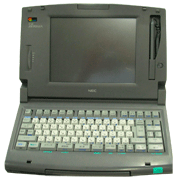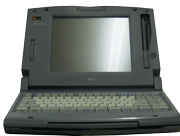NEC rolled out the JX70MA and JX50MA multimedia word processors in October 1996. The word processors were designed to perform many different routine tasks by including such multimedia functions as color copying and Internet and fax communications in addition to paper-document printing.
- The JX70MA and JX50MA had the following features.
- (1)The printer was able to print on both thick picture postcards and thin paper without paper curling when printing horizontally.
- (2)The single paper cassette made large print jobs convenient and could accommodate paper sizes from postcards to B4 sheets.
- (3)Instead of conventional thermal printing, in which the ink on the inked ribbon is melted and transferred to the sheet, the word processors used a sublimation method that vaporizes (sublimates) the ink before fixing it on the sheet. This process reduced color unevenness for photo-quality prints.
- (4)A color scanner head was incorporated in the printer assembly. Photos and magazine clippings up to A4 size could be scanned by simply loading them in the paper cassette.
- (5)Digital images could be quickly imported by connecting to a digital camera.
- (6)Internet sites could be accessed just by choosing a category, and Web pages could be constructed with the feel of creating a document with pictures in a Japanese word processor environment. Created documents could be e-mailed directly.
- (7)The JX70MA and JX50MA could make color copies, B&W copies, and enlarged or reduced copies. Address records could be created and converted to standard address record formats.
| JX70MA | JX50MA | ||
|---|---|---|---|
| Introduced | October 1996 | October 1996 | |
| Display device | Monitor | Backlit, color LCD monitor (DSTN) 640 x 480 pixels, 158 x 211 mm (10.4-inch) |
|
| Horizontal text | 40 Japanese characters x 19 lines (20 x 16 dots, standard display) 80 Japanese characters x 38 lines (10 x 8 dots, condensed display) 20 Japanese characters x 9 lines (40 x 32 dots, expanded display) |
||
| Vertical text | 25 Japanese characters x 30 lines (20 x 16 dots, standard display) 50 Japanese characters x 60 lines (10 x 8 dots, condensed display) 12 Japanese characters x 15 lines (40 x 32 dots, expanded display) |
||
| Entry devices | Keyboard | JIS standard layout (alphanumeric and kana) | |
| Entry modes | JIS input, alphanumeric input, radical input, JIS code, numeric keypad input, symbol input, extended character input | ||
| Conversion methods | AI conversion, clause-level conversion (200 characters / 40 clauses), convert all (clause conversion), kana-kanji conversion, etc. | ||
| Dictionary Dictionaries Standard AI Word management |
~465,000 words ~130,000 words ~320,000 candidate words Storable (~3000 words: two-character word: three-character reading) |
||
| Standard characters | 1990 JIS standard characters | ||
| Extended characters | 10 characters (basic) 104 characters 59 types (number of sample characters) |
||
| Number of characters | Mincho, Gothic, Bold Maru Gothic, Mouhitsu, Kyokasho, Pop: 7,382 characters
Edo characters: 3,791 characters (optional) |
||
| Printing device | Printer Speed Paper widths |
160-dot multi-line printer 225 characters/second (when line spacing set to 53 dots and character spacing set to 0) Prepaid postcard to B4 widths |
|
| Other specifications | External dimensions [mm] Weight Power consumption |
378 x 399 x 95 (w x d x h) 6.7 kg 42 W max., 17 W, standby |
378 x 399 x 95 (w x d x h) 6.5 kg 42 W max., 17 W, standby |



